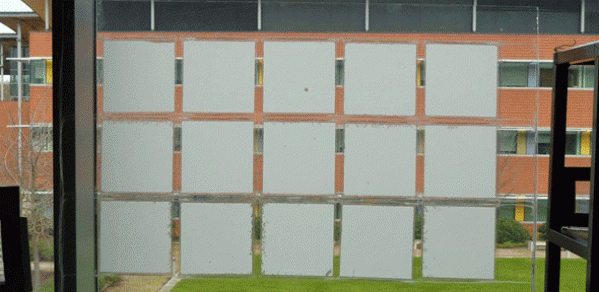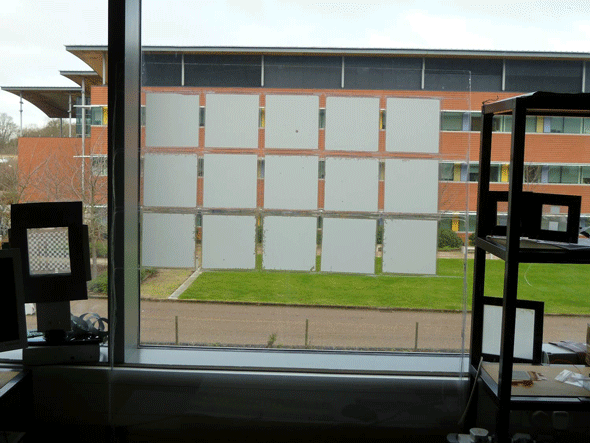
A smart material that switches back and forth between transparent and opaque could be installed in buildings or automobiles, potentially reducing energy bills by avoiding the need for costly air conditioning.
You could have smart windows in an office building that automatically became more or less opaque, depending on the amount of sunlight coming through.
Daping Chu
Imagine a glass skyscraper in which all of the windows could go from clear to opaque at the flick of a switch, allowing occupants to regulate the amount of sunlight coming through the windows without having to rely on costly air conditioning or other artificial methods of temperature control.
Researchers in the Department of Engineering have developed a type of ‘smart’ glass that switches back and forth between transparent and opaque, while using very low amounts of energy. The material, known as Smectic A composites, could be used in buildings, automotive or display applications.
Working with industrial partners including Dow Corning, the Cambridge researchers have been developing ‘Smectic A’ composites over the past two decades. The team, based at the Department of Engineering’s Centre for Advanced Photonics and Electronics (CAPE), has made samples of Smectic A based glass, and is also able to produce it on a roll-to-roll process so that it can be printed onto plastic. It can be switched back and forth from transparent to opaque millions of times, and can be kept in either state for as long as the user wants.
“In addition to going back and forth between clear and opaque, we can also do different levels of opacity, so for example, you could have smart windows in an office building that automatically became more or less opaque, depending on the amount of sunlight coming through,” said Professor Daping Chu, one of the developers of Smectic A technology.
The main component of the developed composite material is made up of a type of liquid crystal known as a ‘smectic’ liquid crystal, which is different than a solid crystal or a liquid.
The simplest definition of a crystal is a solid in which the atoms form a distinct spatial order. A liquid crystal, such as those that are used in many televisions, flows like a liquid, but has some order in its arrangements of molecules. The liquid crystals used in televisions are known as nematic crystals, where the molecules are lined up in the same direction, but are otherwise randomly arranged.
In a smectic liquid crystal, the molecules have a similar directional ordering, but they are also arranged in stacked layers which confines the movement of ionic additives. When a voltage is applied, the liquid crystal molecules all try to align themselves with the electric field, and the material they are embedded in (glass or plastic) will appear transparent.
When the direction of the voltage is slowly changed, the ionic additives disrupt the layer structure of the smectic liquid crystals, which has the result of making the glass or plastic panel appear milky. Increasing the frequency of the voltage causes the movement of the ionic additives to freeze out and then switches the plastic or glass panel back to transparent. These transitions happen in a fraction of a second, and when the voltage is switched off, the material will remain either transparent or opaque until the user wants it to switch again, meaning that unless the material is actively switching states, it requires no power.
Possible applications for smectic A composites include uses in the construction, advertising and automotive industries. For example, it could be applied to glass buildings in order to regulate the amount of sunlight that could get through, or it could be used as a ‘sunroof’ in a car that could be switched back and forth between transparent and opaque.
The work has been patented, and is being commercialised by Cambridge Enterprise, the University’s commercialisation arm, to a major industrial partner through a technology framework transfer agreement.

The original motivation behind the development of smectic A was to develop a type of low-power electronic signage, of the type commonly seen at bus stops, that would use low amounts of energy, and would not fade in bright sunlight.
The original form of smectic A was based on organic materials, but the newer version is silicon-based. One sample of smectic A in a lab at CAPE has been switched back and forth between opaque and transparent more than 27 million times, switching once per second for several years.
“The earlier glass-based samples we produced worked well, but there was a challenge in making them in sizes larger than a metre square,” said Chu. “So we started making it in plastic, which meant we could make bigger samples, and attach it to things like windows in order to retrofit them. This would reduce the effects of solar radiation, since the energy is being scattered rather than absorbed.”
Chu’s team is also working on other possible applications for Smectic A and related technologies, including the possibility of a transparent heat controllable window and non-intrusive public information messaging system.
This article originally appeared on the University of Cambridge website.

